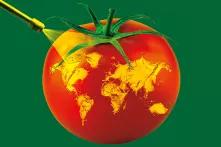
Agricultural robotics, drones, and algorithm-driven technologies for a new way of farming are
becoming big business. They are supposed to help farms cut pesticide use, but there are serious doubts whether this will work.

Agriculture faces major challenges. For one thing, it still has to cope with plant diseases, insect pests, and weeds. And secondly, high consumption of pesticides leads to entirely new risks for both humans and nature. Agricultural technology companies are promising to solve these problems with digital technologies known as smart farming or precision farming. According to a survey, 82 percent of farms in Germany already use digital technologies. 45 percent of the farmers surveyed work with GPS-controlled agricultural machinery and 40 percent use agricultural apps for their smartphones or tablets. 32 percent use IT solutions to apply crop protection products or fertilizers to their fields. The networked agriculture market is expected to grow from $1.8 billion in 2018 to $4.3 billion by 2023, at an annual growth rate of 19.3 percent during the forecast period. Expectations are high: Progressive digitalization is hoped to enable the world’s farms to produce food for nine billion people. Some experts predict digital transformation will raise incomes and protect climate and biodiversity by enabling more precision in pesticide and fertilizer usage – which could lead to lower doses. Digital technologies can also save time which could be used for more labour-intensive methods of pesticide-free cultivation.
One example of the digitalization of agriculture is GPS camera technology. It identifies field areas with weed infestations, so the connected field sprayer opens its nozzles in this section only. Selfpropelled spraying robots use this technology to detect, target, and remove weeds. Drones can be programmed to spot weed nests from the sky. Algorithms can identify and locate diseased or pest infested plants. According to the manufacturers, all this will soon be part of daily farming business.
In a joint trial project, German companies Südzucker AG and the agricultural technology company Amazone in cooperation with the Danish field robot manufacturer FarmDroid are testing how the use of herbicides and insecticides in sugar beet fields can be reduced. The field robot first sows sugar beet seeds in a precise grid using its GPS system. The robot knows the exact position of the beets and hoes next to and between the rows to remove weeds. In the immediate vicinity of the plant, it is difficult to remove all weeds mechanically without damaging the beet, so the robot sprays agrochemicals right next to the beet, which destroys even the last weeds.
Already today, agricultural machinery can identify how well soils are supplied with nutrients. This information can be fed into cropping plan databases to calculate the necessary amount of fertilizer and pesticides to be applied. Big data corporations are playing a significant role in the development and dissemination of the technology, the processing and the use of the data collected. Google for example works with agencies such as the U.S. National Oceanic and Atmospheric Administration (NOAA). The company wants to use its artificial intelligence programs and the weather agency’s vast amounts of data to enable extremely accurate weather forecasts in the future.
Whether the ecological effects of digitalization will be positive or negative depends on many factors. Researchers see potential to reduce pesticide use. On the other hand, there are also so-called rebound effects, for example increased energy consumption due to new technologies or the expansion of intensive production on land previously used only extensively or not at all, or that is ecologically valuable. There is also a risk that smallholder farmers in lower income countries are excluded from this transformation. They may lack access and knowledge to new technologies. Furthermore, many digital tools are only economical when used at large scale.
This could reinforce monopolization and concentration. One example is the market for agricultural machinery. In 1994, the four largest companies controlled less than onethird of the market – after twenty years of consolidation, they already controlled more than half. Players like John Deere are now staking out their territory through collaborations with agrochemical companies. In the past, the company has already cooperated with pesticide manufacturers such as Syngenta, Dow Agrosciences, BASF and Bayer. Other companies such as CNH Industrial and AGCo have also entered into joint ventures. Venture capital interest in software agricultural technologies is rising as well: From 223 billion US dollars in 2015 to more than 700 billion US dollars in 2017.
Civil society organizations warn of a loss of food sovereignty. New tools and techniques are turning land that is currently managed by smallholder families into agro-industries’ profits.
One of the future challenges for policymakers is therefore to prevent the commercialization of climate, nutrition, and crop data and to reinstate farmers sovereignty over their data. Otherwise, there is a risk that digital transformation will contribute to further dependence on unsustainable agriculture.
Due to a printing mistake, the printed version of this article in the Pesticide Atlas 2022 states that Benjamin Gräub is co-author of this chapter. Heike Holdinghausen is the sole author.

